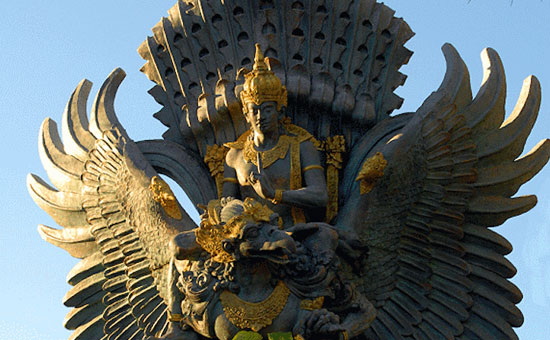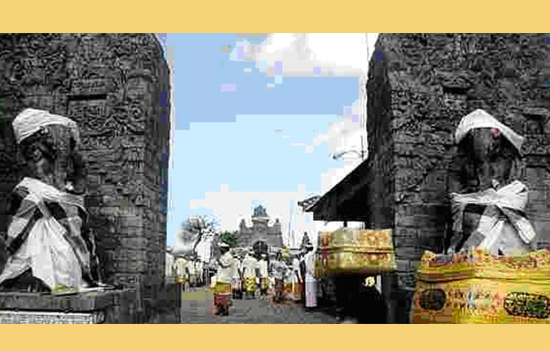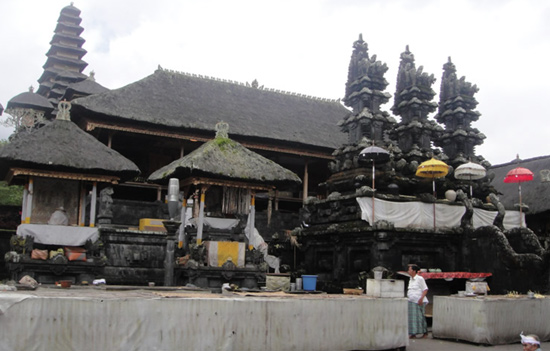- Know about the Temples and Home Design of
Bali seen during a five day tour.
Bali is an Indonesian island. Located to
the southeast of India and surrounded by the Indian Ocean, it has deep-rooted
links with Indian culture. There are more than 10,000 Hindu temples (locally
known as pura), and some that are
over 1000 years old.
This
article was first published in the Bhavan Journal.
We started our journey in Kochi and arrived at Kuala Lumpur (KL) airport on a Malaysian Airlines flight. In KL, we visited the famous ‘Muruga Kshetram’, and explored various historic monuments. The next day, we embarked on our 5-day trip to Bali.
We landed at Denpasar Airport. As we got off the plane, we spotted an aircraft belonging to Garuda Indonesia, the national airline. The moment we saw the name ‘Garuda’, named after Vishnu’s vahana, we knew that the tour was going to be a happy and blessed experience for us all.
 Garuda
Garuda
According to Shakuna Shastram, Garuda darshan, a vision of Garuda or eagle, is
considered to be quite auspicious. A long walk through the airport took us to
the exit, where waiting for our arrival was our tour guide.
We first visited the Pura Luhur Uluwatu
temple. As per the custom observed there, it was mandatory for everyone to tie
a yellow towel around their waist to visit the temple. Men and women wearing
shorts had to drape themselves with a mundu
(a white cloth that covered the body from the waist to the ankles) provided by
the temple. The dance drama called kecak based on the Ramayana is usually
staged within the temple precincts.
 Murtis of Ganesha at entrance of Pura Luhur Uluwatu temple made in 15th
century.
Murtis of Ganesha at entrance of Pura Luhur Uluwatu temple made in 15th
century.
The next day, we visited those villages
where the people of Bali still followed their traditional way of life. Vyasan,
our tour guide, took us to the village of Penglipuran. The pathway was hung
with streamers made of tender coconut leaves intended to give a warm welcome to
tourists. The rectangular courtyards of the houses were fringed with trees
blooming with spiky oleander flowers of different hues, a feast for the eyes.
Each house in the village
was divided into three parts. As we entered, we saw the family shrine. The sanctum was enshrined with three deities. The deities represent the Trimurti—Brahma, Vishnu and Maheswara—whom the Balinese worship devoutly. They do not worship Sri Rama and Sri Krishna separately, as they see them as just avatars of Vishnu. Every household in the village conducts daily worship of their family deities.
 In Besakih courtyard are 3 shrines dedicated to Brahma, Vishnu & Siva.
In Besakih courtyard are 3 shrines dedicated to Brahma, Vishnu & Siva.
Located next to the family shrine is the
kitchen. Like the shrine, the kitchen is regarded as a place of pious sanctity.
Inside the kitchen, we did not spot any modern appliances or utensils. It was
interesting to note that they still use a firewood stove to cook their food.
The living room and the bedroom were
located a little further away from the kitchen. The bathrooms were at the end
of the courtyard. Like the human body comprises of three parts, the head, the
torso and the legs, similarly the houses are structured like the human body.
The head is seen as Sahasrara padmam (thousand-petalled lotus), believed to be the
dwelling place of God. That is the reason why the temple shrines are built near
the front entrance of the house. And as it is through food that life force is
sustained, the kitchens are placed next to the temple shrines. Hence, both
these places are seen as sacred and are separate from the rest of the rooms in
the building. The third part is allocated for sleep, entertainment and other
purposes. The reason for building bathrooms at the end of the courtyard is to
maintain the purity and piety of the house. While explaining the significance
of the house architecture, our guide told us that having the puja room,
kitchen, bedroom, and bathroom constructed close to each other in a house could
deplete positive energy.
 Ganesha somewhere in Bali.
Ganesha somewhere in Bali.
We next travelled to the Kintamani highlands. We had a panoramic view of
the active volcano Mt Batur and Batur Lake. Since 1800, there have been two
dozen volcanic eruptions in the area. That day, we also went to Gajaguha
Kshethram. There, we saw the Ganapati temple and the mesmerising pond beside
it. The Yakshi Pala (milkwood trees, traditionally believed to be the haunt of
spirits) lined the pathway. There were concrete foundations laid around these
wide trees and the bottom of these trees were covered with several varieties of
coloured clothes.
The Balinese believe that these trees have a divine presence and worship them.
Next we visited the Besakih temple. People believe that this temple is
the mother of all temples of this Island. The deities installed in this huge
temple were Brahma, Vishnu and Maheswara. When the devotees visit the temple
they offer red flowers to Brahma, blue to Vishnu and white to Shiva. We could
not fail to notice the cultural similarities with Indian culture.
The Bali residents give a lot of
importance to the Pitru Puja. (A
15-lunar day period when Hindus pay homage to their ancestor, especially
through Tarpana, Pinda Danam (food offerings) and Shraddha.) For showing their
respects to the dear departed, there is a special place earmarked for them, at
a little distance away from the temple. It is believed that while visiting the
temple, one must visit this place too.
In the Tanah
Lot temple, the deity installed is Varuna. It is believed that Varuna
protects the island from getting submerged. During our journey, we saw a large
statue of Varuna at an intersection.
Bali’s beaches have an inexplicable attraction about them. The sight of the waves dancing rhythmically enthrals the onlookers who never get tired of the beautiful sight. The waters near the shores are almost crystal clear. Beyond that, where the waves arise, the sea is green and further beyond, the waters that spread across infinitely, are found in shades of blue. On observing the plethora of colours, one is bound to believe that the Indian Ocean seems to have a special affinity towards this island.
The History of Bali
The name is attributed to Sri Kesari Warmadewa, the first king of Bali, who gave the island its name in 913 CE. The name is found in various inscriptions, including the Blanjong pillar inscription written by Sri Kesari Warmadewa. The Sanskrit name ‘Balidweepa’ means ‘island of sacrifice’.
In Indonesia, where most of the population is Muslim, Bali stands out, with 87 per cent of its people following Hinduism. Richard Mann, in his book, Bali’s First People: the untold story, has described how Hinduism spread in Bali. Maharishi (sage) Markandeya, known to be epically popular, during his world voyage, happened to visit Javadweep and stayed there for a few years. Once, with his disciples, as he sat in meditation on the hills of Javadweep, he seems to have seen the vision of Bali and had this inner call to visit the island. Accordingly, the Maharishi and his group of disciples visited Bali and propagated Hinduism there.
During our visit to Bali, we saw Rishi Markandeya’s statue on a mountain top, which confirmed the myth.
It was during the Gupta dynasty that
Hinduism is known to have spread across the southeastern parts of the Asian
continent. In the 5th century CE, the Pallavas, a dynasty of southern India,
had extended their rule to Southeast Asia. In ancient historical texts on Bali,
there is a mention of the dynasty of Varma Deva Raja. Agastya Maharishi is said
to have visited Java and Bali.
Balinese Hinduism has four castes, but the divisions are not rigid like in India. The castes are the same, though pronounced or written differently—the Brahmana, the Ksatriya, the Wesya and the Sudra. Until 20 years back, the men and women married one another within their caste only. Nowadays, inter-caste marriages are becoming common.
In the 10th century CE, the reign of King Udayana Warmadeva and his wife Mahendra
Dutta is regarded as the Golden Age of Bali.
During his regime, there was progress in
the fields of education, fine arts and agriculture. His palace is preserved as
a historical site even today. The university in Bali is named Udayana after
him.
This article was first published in the Bhavan’s Journal, 16 October, 2024 issue. This article is courtesy and copyright Bhavan’s Journal, Bharatiya Vidya Bhavan, Mumbai-400007. eSamskriti has obtained permission from Bhavan’s Journal to share. Do subscribe to the Bhavan’s Journal – it is very good.
Also
read
1. Temples
of Bali – good pics too.
2. Mother
Temple Bali album
Except cover and Garuda pic, all pictures are copyright esamskriti. They were clicked by Niket Vaidya and Hidayat Atjeh.